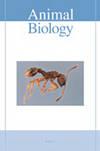A biotechnological method for silkworm sex regulation
IF 0.9
4区 生物学
Q2 ZOOLOGY
引用次数: 0
Abstract
Abstract The aim of this work is to use the biotechnological method of silkworm sex regulation as a breeding method. For this purpose, butterflies were mated immediately after their emergence in a chamber with a constant magnetic field for 4 h. By studying the natural fertilization of the Sheki-2 silkworm in a constant magnetic field, it was possible to change the natural sex ratio of the offspring from 1:1 to 1:3 in favour of males. A direct positive correlation was observed between the magnetic field strength and an increase in the number of males in the offspring, with the maximum number of males observed at a strength of 729.7 kA/m. The developed mathematical model made it possible to calculate the activation coefficient of magnetic fields influencing the cytogenetic process in the silkworm, which was 4.02 × 10 −3 kA/m. An attempt was also made to explain the mechanism behind the cytogenetic influence of a constant magnetic field on possible options for obtaining males during the natural fertilization of silkworm females. Implementation of the developed method in the breeding programme will enhance both the quantity and quality of silkworm productivity. This is achieved by increasing silk yield and improvement of the raw materials obtained from the males. If these positive outcomes are consistently observed in other silkworm breeds, this method has the potential to become widely adopted for large-scale breeding of the entire silkworm population in the country.蚕性调节的生物技术方法
摘要本工作的目的是利用蚕种性别调节的生物技术方法作为一种育种方法。为此,蝴蝶在出现后立即在一个恒定磁场的房间里交配4小时。通过研究恒定磁场下Sheki-2蚕的自然受精,有可能将后代的自然性别比例从1:1改变为1:3,有利于雄性。结果表明,磁场强度与子代雄性数的增加呈显著正相关,在729.7 kA/m的磁场强度下,子代雄性数最大。建立的数学模型可以计算出影响家蚕细胞遗传过程的磁场激活系数为4.02 × 10−3 kA/m。本文还试图解释恒定磁场对蚕雌性自然受精过程中获得雄性的可能选择的细胞遗传学影响背后的机制。在育种计划中实施所开发的方法将提高蚕产量的数量和质量。这是通过提高产丝量和改进从雄性获得的原料来实现的。如果在其他蚕种中持续观察到这些积极结果,则该方法有可能被广泛采用,用于该国整个蚕种的大规模繁殖。
本文章由计算机程序翻译,如有差异,请以英文原文为准。
求助全文
约1分钟内获得全文
求助全文
来源期刊

Animal Biology
生物-动物学
CiteScore
2.10
自引率
0.00%
发文量
34
审稿时长
3 months
期刊介绍:
Animal Biology publishes high quality papers and focuses on integration of the various disciplines within the broad field of zoology. These disciplines include behaviour, developmental biology, ecology, endocrinology, evolutionary biology, genomics, morphology, neurobiology, physiology, systematics and theoretical biology. Purely descriptive papers will not be considered for publication.
Animal Biology is the official journal of the Royal Dutch Zoological Society since its foundation in 1872. The journal was initially called Archives Néerlandaises de Zoologie, which was changed in 1952 to Netherlands Journal of Zoology, the current name was established in 2003.
 求助内容:
求助内容: 应助结果提醒方式:
应助结果提醒方式:


